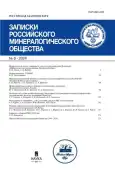Influence of tellurium impurity on the phase transitions and thermal behavior of synthetic Te-bearing insizwaite Pt(Bi,Te)2
- Authors: Mezhueva A.A.1, Karimova O.V.1, Uporova N.S.2, Shiryaev A.A.3, Ivanova L.A.1, Chareeva P.V.1, Chareev D.A.4,5,6
-
Affiliations:
- Institute of Geology of Ore Deposits, RAS
- Institute of Geology and Geochemistry, Urals Branch RAS
- Institute of Physical chemistry and Electrochemistry Russian academy of sciences
- Institute of Experimental Mineralogy, Russian Academy of Sciences
- Ural Federal University
- Dubna State University
- Issue: Vol CLIII, No 6 (2024)
- Pages: 157-171
- Section: ЭКСПЕРИМЕНТАЛЬНАЯ МИНЕРАЛОГИЯ
- URL: https://journals.eco-vector.com/0869-6055/article/view/685301
- DOI: https://doi.org/10.31857/S0869605524060071
- EDN: https://elibrary.ru/NVWEJM
- ID: 685301
Cite item
Abstract
The effect of tellurium impurity on high-temperature transformations in the synthetic phase Pt(Bi,Te)2, which is an analogue of the mineral insizwaite, was studied using high-temperature in-situ methods. The empirical formula of the studied compound is Pt1.04(Bi1.74Te0.22)1.96. According to the differential thermal analysis (DTA + TG) and high temperature X-ray diffraction data, two polymorphic transformations were found for the Pt(Bi,Te)2 phase. The temperatures of phase transitions were slightly shifted compared to the values for the PtBi2 phase. The phase transition from the cubic β-modification to the hexagonal γ-modification of Pt(Bi,Te)2 occurs at a temperature of 523 °C, which is 100 °C higher than in the PtBi2 phase without tellurium impurity. The γ-Pt(Bi,Te)2 is transformed into the high-temperature δ-modification at a temperature of 626 °C, close to the temperature of a similar transition in PtBi2. The isomorphic tellurium impurity in the structure of PtBi2 expands stability field under the influence of high temperatures for its cubic β-modification, which is corresponding to the mineral insizwaite. On the contrary, the stability field of the γ-modification is reduced in the presence of tellurium impurity.
Full Text
About the authors
A. A. Mezhueva
Institute of Geology of Ore Deposits, RAS
Author for correspondence.
Email: ann_mezhueva@mail.ru
Russian Federation, Moscow
O. V. Karimova
Institute of Geology of Ore Deposits, RAS
Email: oxana.karimova@gmail.com
Russian Federation, Moscow
N. S. Uporova
Institute of Geology and Geochemistry, Urals Branch RAS
Email: oxana.karimova@gmail.com
Russian Federation, Ekaterinburg
A. A. Shiryaev
Institute of Physical chemistry and Electrochemistry Russian academy of sciences
Email: oxana.karimova@gmail.com
Russian Federation, Moscow
L. A. Ivanova
Institute of Geology of Ore Deposits, RAS
Email: oxana.karimova@gmail.com
Russian Federation, Moscow
P. V. Chareeva
Institute of Geology of Ore Deposits, RAS
Email: oxana.karimova@gmail.com
Russian Federation, Moscow
D. A. Chareev
Institute of Experimental Mineralogy, Russian Academy of Sciences; Ural Federal University; Dubna State University
Email: oxana.karimova@gmail.com
Russian Federation, Chernogolovka; Ekaterinburg; Dubna
References
- Cabri L.J. The platinum-group minerals. In: The Geology, Geochemistry, Mineralogy and Mineral Beneficiation of Platinum-Group Elements (Ed by L.J. Cabri). Canad. Inst. Mining, Metallurgy and Petroleum. 2002. Spec. Vol. 54. P. 13–131.
- Cabri L.J., Harris D. C. The new mineral insizwaite (PtBi2) and new data on niggliite (PtSn). Miner. Mag. 1972. Vol. 38. C. 794–800.
- Cabri L.J., Laflamme J.H.G. Mineralogy and distribution of platinum-group elements in mill products from Sudbury. In: Applied Mineralogy. Ed. by W. Park, D.M. Hausen and R. Hagni. Proc. 2nd Int. Congress on Applied Mineralogy in the Mineral Industries. The Metallurgical Society. AIME. 1984. P. 911–922.
- Cabri L.J., Laflamme J.H.G. The mineralogy of the platinum-group elements from some Cu-Ni deposits in the Sudbury area, Ontario. Econ. Geol. 1976. V. 71. P. 1159–1195.
- Criddle A.J., Stanley C.J. (Eds). Quantitative Data File for Ore Minerals. 3rd Edition. London: Chapman & Hall, 1993. 635 p.
- Mezhueva A.A., Karimova O.V., Uporova N.S., Shiryaev A.A., Chareev D.A. High-temperature behavior of PtBi2 and possibility of using the mineral insizwaite as a geothermometer. Geol. Ore Deposits. 2022a. Vol. 64. N 5. P. 292–299.
- Mezhueva A.A., Karimova O.V., Zinovieva N.G., Uporova N.S., Shiryaev A.A., Chareev D.A. Thermal transformation of a synthetic analogue of insizwaite PtBi2 on air. Doklady Earth Sci. 2022б. Vol. 506. N 2. P. 740–748.
- Okamoto H. The Bi-Pt (bismuth-platinum) system. J. Phase Equil. 1991. Vol. 12. N 2. P. 207–210.
- Petříček V., Dušek M., Palatinus L. Crystallographic computing system JANA2006: general features. Z. Krist. Crystalline Materials. 2014. Vol. 229. N 5. P. 345–352.
- Rietveld H.M. The Rietveld Method: A Retrospection. Z. Krist. Crystalline Materials. 2010. Vol. 225. N 12. P. 545–547.
- Spiridonov E.M., Serova A.A., Kulikova I.M., Korotaeva N.N., Sereda E.V., Tushentsova I.N., Belyakov S.N., Zhukov N. N. Genetic Pd, Pt, Au, Ag, and Rh mineralogy in Noril’sk sulfide ores. Geol. Ore Deposits. 2015. Vol. 57. N 5. P402–432.
- Zhuravlev N.N., Stepanov A.A. X-ray study of superconducting bismuth-platinum alloys in the temperature range of 20–640°. Crystallography. 1962. Vol. 7. P. 310–311 (in Russian).
Supplementary files
















